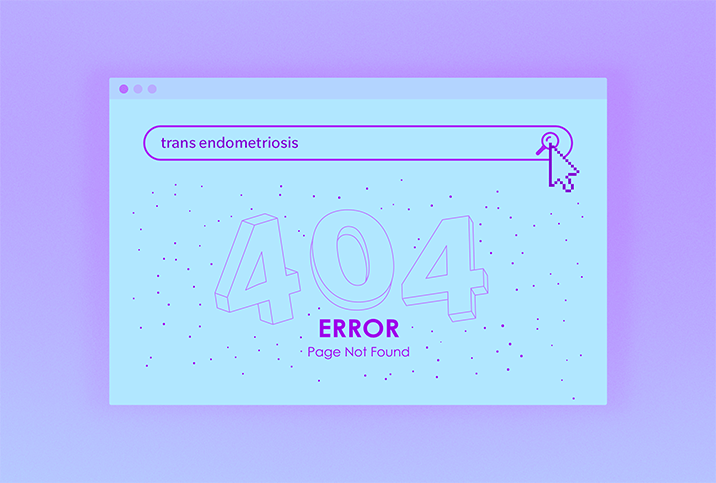When Endometriosis Isn't a 'Woman's Disease'

In 1999, Robert Eads, a transgender man, died of ovarian cancer after more than a dozen doctors refused to treat him for fear it would damage their (straight, cis) reputations. In 2006, Jay Kallio, a trans man suffering from breast cancer, learned of his diagnosis only when a lab technician called to ask how he was dealing with it. Kalio's surgeon didn't know how to talk to Jay about the condition—despite the fact that cis men also get breast cancer—so he didn't bother. Jay also faced hostility from his oncologist, delaying his treatment against the aggressive tumor. In 2020, Jesse Hammonds, a transgender man seeking a hysterectomy, was denied treatment because the hospital had religious objections.
About 1 in 4 transgender people avoid seeking necessary health care because of anticipated discrimination, with transgender men disproportionately represented, according to the 2015 U.S. Transgender Survey published by the National Center for Transgender Equality. An updated 2020 survey found that 1 in 4 transgender people has had to educate their healthcare provider about gender, and that fewer than two-thirds had been gendered correctly and reported feeling respected in a healthcare setting.
When the medical community has a female-centric view on endometriosis, for example, it can be difficult to navigate as a trans or nonbinary person. Nonbinary is an umbrella term that refers to gender identities that are not exclusively male or female.
Being misdiagnosed and ignored can be life-threatening
Beck Severn is a 38-year-old U.S. citizen living in Mexico City, where they are able to support themselves by tutoring children and young adults part time. Severn, who prefers the "they" gender-neutral pronoun, has endometriosis, which occurs when tissue similar to the lining of the uterus grows outside the uterus. In addition to their endometriosis diagnosis, Severn has adenomyosis, celiac disease and experiences mental illness, adding up to a long journey of diagnoses and treatments that has left them with a strained relationship with the healthcare industry.
Severn has had their symptoms passed off as side effects from rough sex, celiac disease, pelvic inflammatory disease from sexually transmitted infections (STIs) that did not exist, stress from depression and PTSD, even long-distance running, being told by a healthcare professional that "women's bodies were just made wrong for running." The symptoms that were ignored included bleeding continuously for months, along with chronic and severe pain.
Eventually, Severn stopped seeking help after their pain was too often questioned and as they felt they were being treated as a "drug seeker" and not a patient truly seeking help. The traumatic experiences Severn had of being ignored while enduring severely painful spontaneous abortions was the last straw. And this was all before Severn came out as nonbinary.
The feelings of abuse and neglect Severn suffered at the hands of healthcare professionals, paired with feelings of gender dysphoria, not only discouraged them from seeking further treatment but also led them to internalize blame for their own condition.
"I blamed myself and my gender representation for, like, not being able to complete a pregnancy," Severn said. "Because I wasn't a woman," they said, they felt like "that's why my body just didn't work right."
"I have always been gender-nonconforming," Severn said of their gender. Because of their nonconformity—short hair, masculine-presenting clothes and visible tattoos—Severn wonders if doctors made assumptions about the validity of their symptoms.
"Maybe they thought I was just angling for a hysterectomy for gender dysphoria reasons," Severn said.
Including all people provides supportive care and recovery
Severn is grateful for the women's communities, online and off, that accepted and embraced them in their recovery from surgeries, and during their journey in accepting themselves and their body as disabled, where medical professionals failed again and again.
"The online community surrounding women's health, specifically for hysterectomies and for endometriosis, I think literally saved my life," Severn said.
Severn's symptoms have progressed to the point that they can no longer afford to avoid doctors' care. Their chronic pain is unbearable as endometrial tissue continues to grow and spread even after a hysterectomy. Endometriosis can impact areas of the body outside the pelvic area—the skin, brain and lungs can also be affected by endometrial tissue in rare cases.
Even though endometriosis has been dubbed the "invisible disease" due to the lack of outward indications, Severn said, "I can't hide it anymore." Over time, some doctors have begun to understand and believe them. They have undergone multiple surgeries in the three years since their official diagnosis. They don't expect much from healthcare professionals but the very basics: to have transness and nonbinary genders understood and affirmed, and to be believed not just about symptoms and experiences, but about who they are in the world.


















